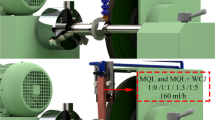Abstract
The cutting fluids contributed for removing chips, cooling, and lubricating, on the other hand, are harmful to the environment. The minimum quantity lubrication technique (MQL) in machining operations proved to be suitable in addition to minimizing the environmental impact. The present work is focused on the drilling of electrolytic copper using biodegradable oil as cutting fluids applied by the MQL technique. The specific cutting pressure, burr height, and maximum diameter were measured varying the cutting parameters, cutting speed, feed, and lubrication condition (dry, flooded, and MQL). A statistical analysis was utilized to determine the influence of cutting parameters in the variables measured. The results indicated that the second-order interactions have a significant influence on the specific cutting pressure and in burr height. The lowest burr height was obtained using flood and MQL. The MQL system demonstrated the lowest specific cutting pressure, while the flood exhibited the best performance for diameter analysis. In addition to this, it can be confirmed that the MQL technique may replace the flooding drilling (abundant flow), minimizing the environmental impact.
Similar content being viewed by others
References
UNIST, Inc. (2017) MQL: the future of metal cutting fluid. Technical Brochure. Grand Rapids (MI) http://unist.com/mql-machining.html. Accessed 10 Jan 2018
Sharma AK, Tiwari AK, Dixit AR (2016) Effects of minimum quantity lubrication (MQL) in machining processes using conventional and nanofluid based cutting fluids: a comprehensive review. J Clean Prod 127:1–18
Kelly JF, Cotterell MG (2002) Minimal lubrication machining of aluminium alloys. J Mater Process Technol 120:327–334
Trent EM, Wright PK (2000) Metal cutting, 4th edn. Butterworth-Heinemann, Woburn
Heisel U, Wallaschek J, Eisseler R, Potthast C (2008) Ultrasonic deep hole drilling in electrolytic copper ECu 57. CIRP Ann Manuf Technol 57:53–56
Davis JR (2001) ASM specialty handbook- copper and copper alloys. ASM Internacional. Ohio. 652 p.
Niknam SA, Zedan Y, Songmene V (2014) Machining burrs formation and deburring of aluminium alloys. Light Metal Alloys Applications, Chapter 5. Publisher: InTech, London .Editor: W. A. Mo nteiro https://doi.org/10.5772/58361
Kim J, Min S, Dornfeld DA (2001) Optimization and control of drilling burr formation of AISI 304L and AISI 4118 based on drilling burr control charts. Int J Mach Tools Manuf 41:923–936
Campos Rubio J, Silva LJ, Leite WO, Panzera TH, Moni Filho S, Davim JP (2013) Investigations on the drilling process of unreinforced and reinforced polyamides using Taguchi method. Compos Part B 55:338–344
Lauderbaugh LK (2009) Analysis of the effects of process parameters on exit burrs in drilling using a combined simulation and experimental approach. J Mater Process Technol 209(4):1909–1919
Wu X, Liang L, He N, Zhao M, Zhan Z (2015) Investigation on the influence of material microstructure on cutting force and bur formation in the micro cutting of copper. Int J Adv Manuf Technol 79:321–327
Rubio JCC, Rezende BA, Vieira LMG, Houmard M (2017) Drilling of aluminium/PE sandwich material with a novel TiO2-coated HSS drill deposited by sol-gel process. Int J Adv Manuf Technol 92:1567–1577
Rezende BA, Silveira ML, Vieira LMG, Abrão AM, Faria PE, Rubio JCC (2016) Investigation on the effect of drill geometry and pilot holes on thrust force and burr height when drilling na aluminium/PE sandwich material. Materials 9(9):774–785
Coelho RT, Braghini A Jr, Valente CMO, Medalha GC (2003) Experimental evaluation of cutting force parameters applying mechanistic model in orthogonal milling. J Braz Soc Mech Sci Eng 25(3):247–253
Abrão, A. M.; Faria P.E.; Campos Rubio, J. C.; P. Reis, P.; Davim, J. P., 2007. Drilling of fiber reinforced plastics: a review. J Mater Process Technol 186, 1–7
Bhowmick S, Alpas AT (2011) The role of diamond-like carbon coated drills on minimum quantity lubrication drilling of magnesium alloys. Surf Coat Technol 205:5302–5311
Qin S, Li Z, Guo G, An Q, Chen M, Ming W (2016) Analysis of minimum quantity lubrication (MQL) for different coating tools during turning of TC11 titanium alloy. Materials 9:804. https://doi.org/10.3390/ma9100804
Liu Z, Jiang Q, Cong W, Li T, Zhang L (2017) Comparative study for environmental performances of traditional manufacturing and directed energy deposition processes. Int J Environ Sci Technol 15:2273–2282. https://doi.org/10.1007/s13762-017-1622-6
Giasin K, Soberanis SA (2016) Evaluation of workpiece temperature during drilling of GLARE fiber metal laminates using infrared techniques: effect of cutting parameters, fiber orientation and spray mist application. Materials 9:622. https://doi.org/10.3390/ma9080622
Vedrtnam A, Pawar SJ (2018) Experimental and simulation studies on fatigue behavior of laminated glass having polyvinyl butyral and ethyl vinylacetate interlayers. Fatigue Fract Eng Mater Struct 41:1437–1446. https://doi.org/10.1111/ffe.12788
Vedrtnam A (2019) Novel method for improving fatigue behavior of carbon fiber reinforced epoxy composite. Compos Part B 157:305–321. https://doi.org/10.1016/j.compositesb.2018.08.062
Holmberg K, Mattews A (2009) Coatings tribology – properties, techniques and applications in surface engineering, engineering series 56, Second edn. Elsevier, Amsterdam 577 pp
Montgomery DC (2013) Design and analysis of experiments, Eighth edn. John Wiley & Sons, Inc., New York ISBN 978-1-118-14692-7
Acknowledgements
Would like to thank the University of Santiago (USACH) for support offered during the work.
Funding
The authors would like to thank the Brazilian Research Agencies, CNPq, FAPEMIG, and CAPES for the financial support provided.
Author information
Authors and Affiliations
Corresponding author
Rights and permissions
About this article
Cite this article
Rubio, J.C.C., Rezende, B.A., Vieira, L.M.G. et al. Comparative study on lubricating and cooling conditions in the drilling process of electrolytic copper. Int J Adv Manuf Technol 101, 2633–2641 (2019). https://doi.org/10.1007/s00170-018-3139-7
Received:
Accepted:
Published:
Issue Date:
DOI: https://doi.org/10.1007/s00170-018-3139-7



